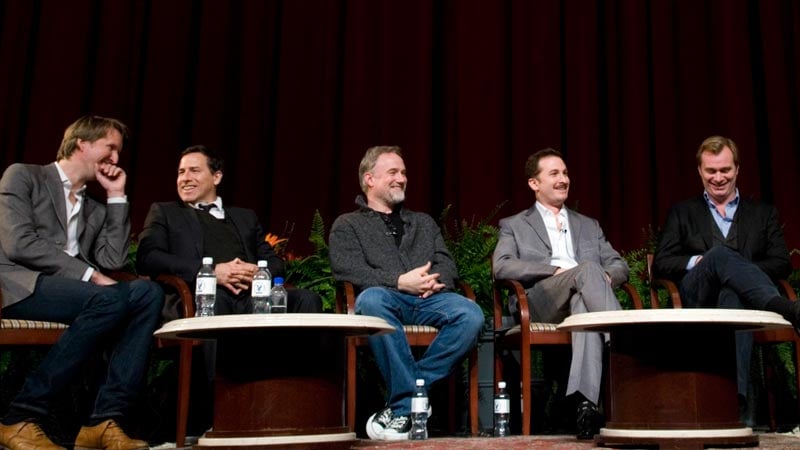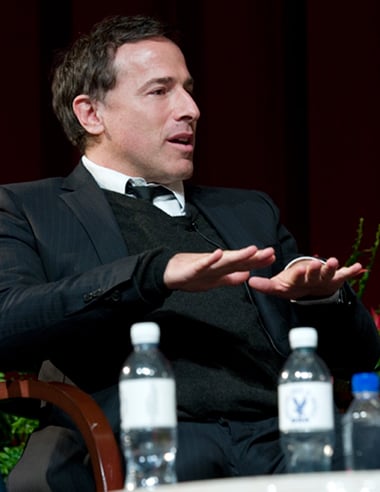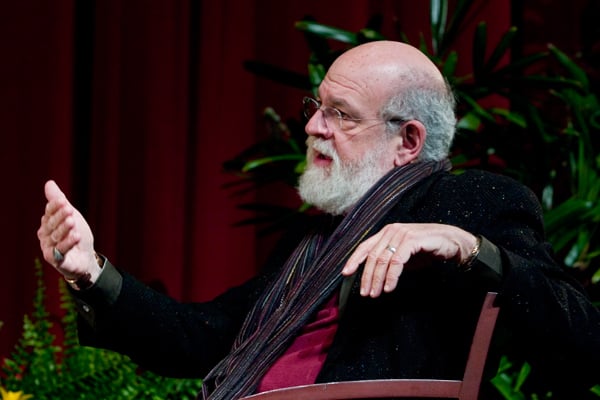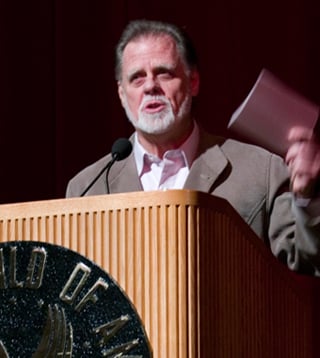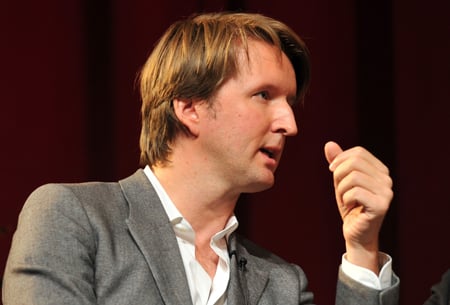The DGA held its twentieth annual "Meet The Nominees: Feature Film" symposium on Saturday morning, January 29, 2011. Directors Darren Aronofsky (Black Swan), David Fincher (The Social Network), Tom Hooper (The King's Speech), Christopher Nolan (Inception), and David O. Russell (The Fighter) joined moderator/DGA Special Projects Committee Chair Jeremy Kagan onstage before a standing room only crowd in the Guild's Los Angeles Theatre. For the first time ever, the event was also viewed by DGA members in New York via a simulcast held at DGA Headquarters.
DGA President Taylor Hackford welcomed members and their guests to one of the Guild’s most prestigious events. "We are honored to have all five of this year's nominees for Outstanding Achievement in Feature Film here today," said Hackford. "They have all created astonishing films that demonstrate the passion and diversity of filmmaking today."
After a screening of clips from each film, the directors joined Kagan onstage. "This is a rare opportunity to be in conversation with five amazing directors and discuss what ‘the process’ is and how you work it." said Kagan. He then kicked off the discussion by asking each director about the locations they chose to stage their films.
Nolan spoke about the challenges he faced in bringing Inception’s dream worlds to film. "What I felt I hadn’t seen done in a film was treating the dream world with a sense of reality, so that while you’re in the dream you think it’s real, which is one of the story points. We went to six different countries and staged a lot of things in-camera, even when we get into the more fanciful worlds like limbo for example. The clip you just saw was kind of a mish-mash of 2001 and Citizen Kane scrambled together. When I think of dreams, I tend to relate it to movies. I’m a big film fan, but I think a lot of people are and it seemed likely to me that you could reference those things and they would have a resonant quality even if the reference wasn't explicit.'
Aronofsky spoke about the difficulty of finding the right space in New York to film Black Swan. “I wanted to get that kind of New York 1970s, Rosemary’s Baby sense of the city. I had this idea of an upper West Side apartment, but we actually had to shoot in Brooklyn. When you’re reading a script, you imagine something that’s completely different when you’re looking at locations. There’s a big resistance to getting over that hump. I wanted the whole film to be a ballet so I was looking for ways to choreograph every scene as a dance. But when you’re in a real location, there are budgetary realities so it’s not always a fully creative decision. It’s often connected to the logistics of shooting on location.”
Fincher amused the audience with his recollection of trying to get Harvard University to allow the production company to film The Social Network on its hallowed campus. “The script was kind of contained to around six square blocks and so when we got there I thought, ‘this is too easy. We’ll go to Harvard, they’ll say yes and then we’ll shoot here and be done by October.’ That didn’t happen. They tell you up front there’s no chance, but let’s see you dance. We tried every kind of inroad, but they finally came back with, ‘Two trees died during the filming of Love Story and we’d never want to see that happen again.’” Fincher eventually filmed on the Johns Hopkins campus. “They were fantastic to us. Ironically, when we were talking about it, we were thinking about The Paper Chase, only to find out that movie was shot at USC.”
Russell spoke about using the actual working class community of Lowell, MA to recreate his scenes for The Fighter. “It meant the world for us to be there and be with the actual family. It was so personal to the family and exciting to this working class town for us to be there. It was the opposite of New York as everybody was like ‘please film over here,’ and ‘what can we do to help you?’ We used the actual gym they trained in, and shot some of the early fight scenes there. I realized how Scorsese had gotten away with that in Raging Bull. When you black out a space, you can take the lights and put them far back and suddenly it looks like you have all this space. I like wide shots with large barren spaces. We even shot in a home they had lived in for awhile. And in Lowell, everything was real. We love it up there. I still go there.”
Hooper was enthusiastic about being able to shoot The King’'s Speech in the city where the story took place. “The last time I filmed at home in London was back in 2003 for Prime Suspect. Since then I’ve had to recreate London in Vilnius, Lithuania; Richmond, Virginia and Budapest, Hungary. I tell you that shooting London for London is a fantastic double. Almost all the film is locations except for Logue’s apartment. I love the serendipity of the process. No matter how much you’ve pre-visualized your movie, going out into the world and looking at locations allows you to make discoveries that take you in different directions. I like opening myself up to the chances of that. That process of going out into the world and learning from the world I find really helpful.”
With that start, the panel was off into a morning that offered insights into each of these motion pictures as individual works of art, and behind-the-scenes views of directors at the height of their craft. In a matter of hours, one of them would win the Outstanding Directorial Achievement in Feature Film Award, but the morning was one of camaraderie and exploration into the elements involved in creating a film worthy of one of the Guild’s highest honors.
